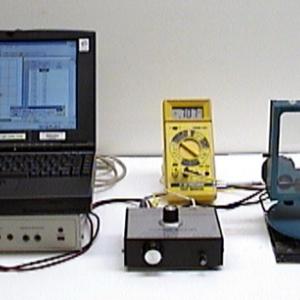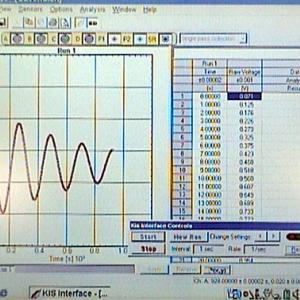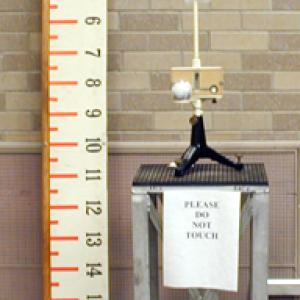College of Liberal Arts & Sciences
1L10.30 - Cavendish Balance
The computerized Cavendish is designed to be worked with an interface. Results can be obtained within a matter of minutes instead of a 1 hour class period. Usually 15 minutes is enough time to stabilize the apparatus once the torsion arm has been released. Once the balls are in position wait several minutes before turning on the interface. When the balls are moved to their new position again wait several minutes before turning on the interface. The multimeter allows you to zero the apparatus when it is at equilibrium and also allows you to monitor the voltage so that you can set the proper scale.
In Lecture Room 1 you may set the balance up on the sunken piling and special stand that is available and set the demo scale on the opposite wall, however this is very time consuming and almost always unnecessary. Take it into the lecture room at least 1 hr ahead of demonstration time and prepare it for actual use. Make sure that nothing disturbs the table after this time so that the balance has time to reach a relative equilibrium. For actual demonstration all the teacher should have to do is turn on the laser and mark on the wall where the starting point is. Then change the masses and wait until the end of class for equilibrium and the marking of the second point. Distance apart should be about 18 inches but this also depends upon how close the laser is to the balance.
- Paul Hewitt, "Figuring Physics", TPT, Vol. 62, #8, Nov. 2024, p. 691.
- Michele Dragoni, "Gravity in Earth's Interior", TPT, Vol. 58, #2, Feb. 2020, p. 97.
- Jeff Sanny and David Smith, "How Spherical Is a Cube (Gravitationally)", TPT, Vol. 53, #2, Feb. 2015, p. 111.
- Marc Reif, "Caution: Strong Gravitational Field Present", TPT, Vol. 52, #5, May 2014, p. 309.
- David Keeports, "A More General 'U = mgh'", TPT, Vol. 47, #5, May 2009, p. 286.
- Paul Hewiit, "Figuring Physics: Gravity Force on Shuttle", TPT, Vol. 42, #6, Sept. 2004, p. 374.
- Brian W. Holmes, "Shells", TPT, Vol. 42, #4, Apr. 2004, p. 196.
- Lawrence Ruby, "Author's Reply", TPT, Vol. 42, #1, Jan. 2004, p. 5.
- Martin Lieberherr, "Gravitational Field Due to a Sphere: A Geometrical Argument", TPT, Vol. 42, #1, Jan. 2004, p. 5.
- George K. Horton, "With or Without Calculus — That is the Question", TPT, Vol. 42, #1, Jan. 2004, p. 4.
- Lawrence Ruby, "Gravitational Force Due to a Sphere: A Noncalculus Calculation", TPT, Vol. 41, #7, Oct. 2003, p. 416.
- Paul Hewitt, "Figuring Physics: Plate on the Earth", TPT, Vol. 40, #8, Nov. 2002, p. 456.
- Sean P. Lally, "Henry Cavendish and the Density of the Earth", TPT, Vol. 37, #1, Jan. 1999, p. 34.
- James A. Flaten, "Beyond Newton's Law of Universal Gravitation", TPT, Vol. 35, #4, Apr. 1997, p. 248.
- "Erratum", TPT, Vol. 34, #6, Sept. 1996, p. 329.
- Paul Hewitt, "Figuring Physics", TPT, Vol. 33, #9, Dec. 1995, p. 581.
- Peter M. Hall and David J. Hall, "Gravity in a Mine Shaft", TPT, Vol. 33, #8, Nov. 1995, p. 525.
- A. James Mallmann, Jeffrey L. Hock, and Kent M. Ogden, "Surprising Facts about Gravitational Forces", TPT, Vol. 32, #8, Nov. 1994, p. 492.
- Edward Kluk and John L. Lopez, "Don't Use Airtracks to Measure Gravity Acceleration", TPT, Vol. 30, #1, Jan. 1992, p. 48.
- Fritz Schoch and Walter Winiger, "How to Measure g Easily with ≊10−4 Precision in the Beginners’ Lab", TPT, Vol. 29, #2, Feb. 1991, p. 98.
- John E. Carlson, "Cavendish Experiment", TPT, Vol. 27, #7, Oct. 1989, p. 562.
- P. K. MacKeown, "Gravity is Geometry", TPT, Vol. 22, #9, Dec. 1984, p. 557.
- Michael S. Saulnier and David Frisch, "Measurement of the Gravitational Constant Without Torsion", AJP, Vol. 57, #5, May 1989, p. 417.
- A. M. D’Anci and C. E. Armentrout, "A Light-Beam Data Recorder for Determination of The Gravitational Constant: Anomalous Driven Oscillations of a Gravitation Constant: Anomalous Driven Oscillations of a Gravitation Torsion Balance", AJP, Vol. 56, #4, Apr. 1988, p. 348.
- C. W. Fischer, J. L. Hunt, and P. Sawatzky, "Automatic Recording for the Cavendish Balance", AJP, Vol. 55, #9, Sep. 1987, p. 855.
- J.‐Cl. Dousse and Ch. Rhême, "A Student Experiment for Accurate Measurements of the Newtonian Gravitational Constant", AJP, Vol. 55, #8, Aug. 1987, p. 706.
- R. A. Dunlap, "The Use of Amorphous Metallic Ribbon as a Torsion Spring for the Measurement of the Gravitational Constant", AJP, Vol. 55, #4, Apr. 1987, p. 380.
- B. E. Clotfelter, "The Cavendish Experiment as Cavendish Knew It", AJP, Vol. 55, #3, Mar. 1987, p. 210.
- Munawar Karim and William J. Toohey, "Compensated Cavendish Balance, "AJP, Vol. 54, #11, Nov. 1986, p. 1043.
- Glenn E. Shaw, "Harmonically Forced Cavendish Balance", AJP, Vol. 51, #10, Oct. 1983, p. 913.
- R. E. Crandall, "Electronic Cavendish Device", AJP, Vol. 51, #4, Apr. 1983, p. 367.
- B. Block, R. D. Moore, and P. Roos, "Do-It-Yourself Cavendish Balance", AJP, Vol. 33, #11, Nov. 1965, p. 963.
- Steven K. Blau, "Evidence for Primordial Gravitational Waves Negated", Physics Today, Vol. 68, #4, Apr. 2015, p. 17.
- Stephen G. Benka, "Another Close Look at 'Big G'", Physics Today, Vol. 66, #10, Oct. 2013, p. 17.
- Peter J. Mohr and Barry N. Taylor, "Adjusting the Values of the Fundamental Constants", Physics Today, Vol. 54, #3, Mar. 2001, p. 29.
- Bertram Schwarzschild, "Theorists and Experimenters Seek To Learn Why Gravity Is So Weak", Physics Today, Vol. 53, #9, Sept. 2000, p. 22.
- Bertram Schwarzschild, "Our Knowledge of G Gets Worse, Then Better", Physics Today, Vol. 53, #7, July 2000, p. 21.
- Jearl Walker, "The Amateur Scientist: Simple and Vivid Demonstrations of Advanced Concepts in Physics", Scientific American, Vol. 248, #1, Jan. 1983, p. 130.
- C. L. Stong, "The Amateur Scientist: How to Repeat Cavendish's Experiment for Determining the Constant of Gravity", Scientific American, Vol. 209, #3, Sept. 1963, p. 267.
- Jon Lackman, "New Theories Test Our Understanding of Nature’s Most Elemental Force", Popular Science, Vol. 282, #10, Oct. 2010, p. 29.
- G. D. Freier and F. J. Anderson, "Mn-1", A Demonstration Handbook for Physics.
- Richard Manliffe Sutton, "M-128", Demonstration Experiments in Physics.
- Martin C. Sagendorf, "Where is 'Down'?", Physics Demonstration Apparatus, 2009. p. 72.
- R. W. Pohl, "4. Verification of the General Law of Attraction by Laboratory Experiment", Physical Principles of Mechanics and Acoustics, p. 68.
- David Kutliroff, "34. Building and Illustrating a Home - Made Cavendish Apparatus", 101 Classroom Demonstrations and Experiments For Physics Teachers, p. 78.
- Jearl Walker, "1.157. The Home of the Little Prince", The Flying Circus of Physics Ed. 2, p. 75.
- Yaakov Kraftmakher, "7.19. Cavendish Experiment", Experiments and Demonstrations in Physics, ISBN 981-256-602-3, p. 491.
- Robert P. Crease, "Weighing The World: Cavendish's Austere Experiment", The Prism & The Pendulum, Ch. 5, p. 82 - 99.
- Curt Suplee, "A Situation of Gravity", Everyday Science Explained, National Geographic, p. 78 - 79.
- Herb Strongin, “Investigating Gravity and How to Overcome It“, Science on a Shoestring, p. 124.
- Julius Sumner Miller, Q106 & A106, Millergrams I – Some Enchanting Questions for Enquiring Minds, p. 68 & 115.
Disclaimer: These demonstrations are provided only for illustrative use by persons affiliated with The University of Iowa and only under the direction of a trained instructor or physicist. The University of Iowa is not responsible for demonstrations performed by those using their own equipment or who choose to use this reference material for their own purpose. The demonstrations included here are within the public domain and can be found in materials contained in libraries, bookstores, and through electronic sources. Performing all or any portion of any of these demonstrations, with or without revisions not depicted here entails inherent risks. These risks include, without limitation, bodily injury (and possibly death), including risks to health that may be temporary or permanent and that may exacerbate a pre-existing medical condition; and property loss or damage. Anyone performing any part of these demonstrations, even with revisions, knowingly and voluntarily assumes all risks associated with them.



